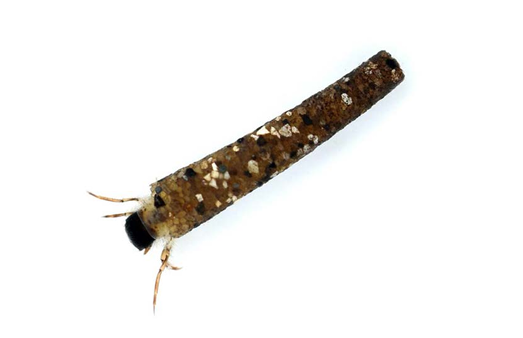Aquatic Invertebrates in the Avoca–Avonmore Catchment
Most of the animal life in the rivers and lakes of the Avoca–Avonmore catchment consists of aquatic invertebrates such as insects, crustaceans, snails, worms, and leeches. Insects are the most diverse group and include mayflies, stoneflies, caddis flies, beetles, and two-winged flies such as midges and craneflies. Their juvenile stages live on the riverbed or among aquatic plants, emerging as winged adults in spring and summer.
Many species depend on clean, unpolluted water, so their presence is a strong sign of good water quality. These invertebrates form the foundation of the river ecosystem, supporting fish and reflecting the health of the catchment’s waters.
Flat mayfly nymph
Photo courtesy of Atlantic Salmon Trust
A detailed study of the Glenealo River in 2004–2005 recorded 79 species of macroinvertebrates, with insects making up over 90%. The river’s fast, stony flow supports algae that form the base of the food web. Mayfly nymphs graze on these algae and are an important food for trout and young salmon. Twelve of Ireland’s 35 mayfly species are found in the Avoca catchment. Among them, the March brown, classed as “Vulnerable,” and the upland summer mayfly, ranked as “Near Threatened,” are of conservation concern.
Stoneflies are well represented in the catchment’s clean, turbulent rivers, with 16 of Ireland’s 20 species found here. They thrive in cool, stony streams and are indicators of high oxygen levels. Some, like the scarce early brown, are now critically endangered.
Case caddis larvae
Photo courtesy of Atlantic Salmon Trust
Caddis flies are another major group, with at least 66 species recorded. Their larvae are known for building protective cases from small stones or plant material. Both larvae and adults are an important food source for fish. Common species include the Welshman’s button and the caseless grey flags.
Beetles are also diverse, with around 20 species recorded, especially riffle beetles that live among stones in fast-flowing water. Two-winged flies such as blackflies, craneflies, and midges are common, particularly in areas affected by organic pollution.
Other groups include freshwater shrimp, found mainly in the lower rivers, and molluscs such as the river limpet and the freshwater pearl mussel. Pearl mussels are remarkable creatures that can live for over 100 years but are now critically endangered. They require clean, oxygen-rich water and are much reduced in number within the catchment.


